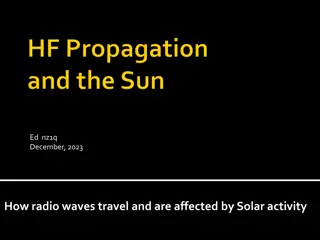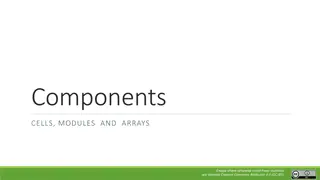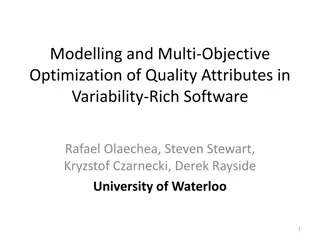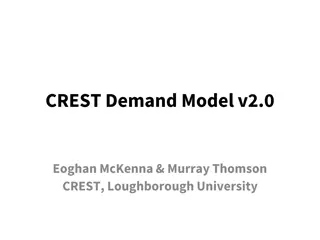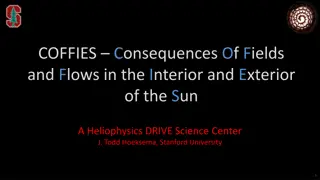Building an Active Region Database for Solar Irradiance Variability Using SDO Images
San Fernando Observatory (SFO) at California State University Northridge is leveraging ground-based and space-based images to fill data gaps in solar images and develop a database for studying Total Solar Irradiance (TSI) variability. By extracting active-region information from Solar Dynamics Observatory (SDO) images and utilizing unique algorithms, SFO aims to enhance understanding of solar irradiance variation through two-parameter models and examination of sunspot and faculae data against TSI measurements.
Download Presentation

Please find below an Image/Link to download the presentation.
The content on the website is provided AS IS for your information and personal use only. It may not be sold, licensed, or shared on other websites without obtaining consent from the author.If you encounter any issues during the download, it is possible that the publisher has removed the file from their server.
You are allowed to download the files provided on this website for personal or commercial use, subject to the condition that they are used lawfully. All files are the property of their respective owners.
The content on the website is provided AS IS for your information and personal use only. It may not be sold, licensed, or shared on other websites without obtaining consent from the author.
E N D
Presentation Transcript
Building an active-region database from Solar Dynamics Observatory (SDO) full-disk images to support studies of Total Solar Irradiance (TSI) variability G.A. Chapman, D.P. Choudhary, A.M. Cookson gary.chapman@csun.edu; debiprasad.choudhary@csun.edu; angela.cookson@csun.edu San Fernando Observatory (SFO) California State University Northridge 18111 Nordhoff St, Northridge, CA 91330-8268
Abstract The San Fernando Observatory (SFO) has been taking photometric, full-disk images of the Sun since 1986 in several wavelengths. Being ground-based, it is subject to atmospheric and environmental constraints, primarily weather and California wildfires, resulting in numerous gaps in the dataset. We attempt (1) to fill those data gaps with active-region information extracted from space-based (no atmospheric constraints) SDO full-disk images processed with SFO algorithms and (2) to build a separate, stand-alone database of dark sunspot and bright facular indices from appropriate wavelength SDO images. These are the first steps.
The Solar Irradiance Variation Question Spacecraft experiments show that Total Solar Irradiance (TSI) varies with the solar activity cycle, with maximum irradiance at times of maximum activity. Obtaining sunspot deficit and facular excess values through a Feature-Identification method on ground-based images allows the development of a two-parameter model that, when regressed against space-based TSI, helps in the understanding of irradiance variation. A second method, Photometric Sum, can also be used in a two- parameter model to further contribute to that understanding. The question here is whether or not this same information can be extracted from space-based full-disk images, namely Solar Dynamics Observatory (SDO) AIA images and HMI intensitygrams, using the same software algorithms that SFO employs for its ground-based full-disk images.
Examining solar irradiance variation using a two-parameter model The San Fernando Observatory approach to contributing to the understanding of irradiance variation uses two separate two-parameter models based on the following: (1) sunspot and faculae information obtained from active-region feature identification and/or (2) photometric sums ( ) from red and Ca II K full-disk photometric images. These values are regressed against Total Solar Irradiance (TSI) to determine how well they explain variation.
SFO data set: image acquisition The San Fernando Observatory (SFO) has a long dataset beginning in 1986, the product of two different-sized aperture telescopes (CFDT1 and CFDT2) that take full-disk photometric images in several different wavelengths. (Walton et al (1998 Sol.Phys.179, 31; www.csun.edu/sfo)) Each telescope uses a linear diode array, requiring a drift-scan method for obtaining full-disk images in order to build a square image, either 512 x 512 pixels (5 resolution) for CFDT1 or 1024 x 1024 pixels (2.5 resolution) for CFDT2. A scan takes approximately 2 to 3 minutes to complete. Primary wavelengths are red (672.3nm, 10nm bandpass) from which sunspot information is extracted and Ca II K (393.4nm, 1nm bandpass) from which faculae information is obtained.
Two examples of SFO images taken September 4, 2001 CFDT1 red (672.3nm) CFDT1 CaK (393.4nm)
SFO dataset: extracting solar information Images are processed within the IRAF environment using software algorithms developed primarily in-house. Algorithms produce calibrated photometric contrast images and determine relative irradiance contributions of solar surface features (sunspots, faculae, and plage) from these images. (Walton et al (1998 Sol.Phys. 179 31)) Several solar indices are computed, including photometric sums ( ), sunspot areas and deficits, and faculae areas and excesses, for the purpose of TSI modeling. (Preminger, Walton, & Chapman 2001, Sol.Phys. 202 53) Two methods are used to determine solar information: Feature Identification and Photometric Sum.
Two methods for constructing a two-parameter model Feature identification uses a threshold method to identify contiguous pixels on a photometric contrast image that are either darker or lighter than the surrounding quiet Sun surface based on a pre-determined contrast criteria. This method identifies sunspots on red (672.3nm) images and faculae on Ca II K (393.4nm) images. We then identify and compute several different parameters, the most important of which, for irradiance variability studies, are sunspot areas and deficits; and faculae areas, faculae excesses, and Ca II K excesses. Secondary indices, such as umbral areas, are computed for use in other projects.
Two methods for constructing a two-parameter model, continued: Photometric sum ( ), which does not rely on feature identification, has proven to be one of the most successful photometric indices produced (Preminger, Walton, & Chapman 2002, JGR, 107 6). measures the relative change in spectral irradiance in filter passband due to all features and assumes image noise is symmetric around zero, causing bright and dark noise pixels to cancel, leaving only contributions from real features. r and Kare disk-integrated sums determined from red and Ca II K contrast-image pixels, respectively; each pixel is weighted by the appropriate limb-darkening. r measures irradiance contributions from photospheric structures seen in red continuum images. K measures variability of the upper photosphere/lower chromosphere seen in Ca II K images.
Previous work has shown that a combination of SFO randKclosely correlates to SORCE TSI with R2=0.95. The indices sum all dark and bright pixels across an image (red and Ca II K) to obtain a single value for that image, with no explicit feature identification. The remaining 0.05 can be attributed to noise, both instrumental and solar intensity.
Solar Dynamics Observatory datasets We needed separate images that would provide sunspot and facular information, images originating in similar regions of the Sun as those that SFO observes in. We began with those from which we could extract facular data. We chose wavelengths that originated close to the regions observed by SFO s Ca II K. We also needed images that had a clear and discernable limb in order for SFO s software to work. Ca II K (393.4 nm) looks at the upper photosphere/lower chromosphere. SDO 1600 originates in the upper photosphere and in the transition region between the chromosphere and corona. SDO 1700 is in the ultraviolet continuum, looking at the surface of the Sun and the chromosphere. (www.nasa.gov/content/goddard/sdo-aia-1600-angstrom) (www.nasa.gov/content/goddard/sdo-aia-1700-angstrom)
The method for determining the feasibility of using SDO 1600 and 1700 for solar faculae information Data extracted from SFO and SDO images, both sets processed with the SFO algorithms and software, were used in a series of multi-variable linear regressions against space-based TSI [SORCE/TSI]. The data cover an 8-year period from 2011-01-01 through 2018-12-31. Numerous data gaps occur in all data sets due to ground-based weather conditions and/or instrumental issues. Space-based TSI has an instrumental data gap; SDO 1600 and 1700 sets are of different lengths. Data sets vary from 784-801 data points.
The regressions: 8 sets of data Sunspot deficit and r data come from SFO red images, both CFDT1 and CFDT2, for all regressions. Facular excess and K data come from both CFDT1 and CFDT2 SFO Ca II K images and SDO 1600 and SDO 1700 . Feature identification and photometric sum were both used. SFO K data comes from three different indices. CFDT1 produces one set of data; CFDT2 produces one set of data; and a composite K-line dataset is produced to account for filter changes in CFDT1 over the length of the project.
R from multi-linear regressions using CFDT1 spot deficit (def) and r SDO 1600 Feature identification Photometric sum (CFDT1 spot deficit & K excess) v TSI (CFDT1 r & K) v TSI (def + cfdt1K) = 0.8224 ( r + cfdt1 K) = 0.8779 (def + comp K) = 0.8306 ( r + comp K) = 0.8782 (def + cfdt2 K) = 0.8267 ( r + cfdt2 K) = 0.8700 (def + SDO 1600 K) = 0.7241 ( r + SDO 1600 K) = 0.7934 SDO 1700 SDO 1700 (CFDT1 spot deficit & K excess) v TSI (CFDT1 r & K) v TSI (def + cfdt1K) = 0.8262 ( r + cfdt1 K) = 0.8807 (def + comp K) = 0.8343 ( r + comp K) = 0.8809 (def + cfdt2 K) = 0.8303 ( r + cfdt2 K) = 0.8727 (def + SDO 1700 K) = 0.8514 ( r + SDO 1600 K) = 0.8957
R from multi-linear regressions using CFDT2 spot deficit (def) and r SDO 1600 Feature identification Photometric sum (CFDT2 spot deficit & K excess) v TSI (CFDT2 r & K) v TSI (def + cfdt1K) = 0.8267 ( r + cfdt1 K) = 0.8819 (def + comp K) = 0.8364 ( r + comp K) = 0.8848 (def + cfdt2 K) = 0.8337 ( r + cfdt2 K) = 0.8809 (def + SDO 1600 K) = 0.7237 ( r + SDO 1600 K) = 0.8155 SDO 1700 SDO 1700 (CFDT2 spot deficit & K excess) v TSI (CFDT2 r & K) v TSI (def + cfdt1K) = 0.8278 ( r + cfdt1 K) = 0.8822 (def + comp K) = 0.8374 ( r + comp K) = 0.8851 (def + cfdt2 K) = 0.8347 ( r + cfdt2 K) = 0.8812 (def + SDO 1700 K) = 0.8536 ( r + SDO 1700 K) = 0.8912
Results for faculae information For all regressions using only SFO data, s give better fits than feature identification. The slight differences between sets using SDO 1600 and SDO 1700 are due to the differences in the number of data points the wavelength set. SDO 1600 gives poorer fits than SFO data for both feature identification and photometric sum . SDO 1700 gives slightly better fits than SFO for both feature identification and photometric sum . While SDO 1700 fits give only slightly better fits than SFO data alone, SDO 1600 fits are significantly poorer. It comes as no surprise that 1700 gives closer results to Ca II K than 1600 since they originate in very similar regions of the solar atmosphere. Ca II K (393.4 nm) looks at the upper photosphere/lower chromosphere and SDO 1700 is in the ultraviolet continuum, looking at the surface of the Sun and the chromosphere.
Sunspot data from SDO/HMI Intensitygrams Question: can we extract sunspot data from continuum intensitygrams using SFO algorithms? Processed 1-year s worth (2011) of HMI images and were able to fit limb darkening curves and create contrast images from which we could obtain sunspot areas and deficits. Compared them to SFO 672.3 nm (red continuum) image data with the following results: HMI spot deficit vs SFO deficit: R2 = 0.9455 HMI vs SFO r R2 = 0.7196 This was a surprise since usually Photometric Sum gives a slightly better fit than Feature Identification.
Multilinear regressions against Total Solar Irradiance Multilinear regressions were performed to see whether it might be feasible to create a meaningful SDO dataset of solar indices based on SDO/HMI intensitygrams and SDO/AIA 1700 images with the following results: (HMI spot deficit + CFDT Ca II K facular excess) vs TSI: R2 = 0.8498 (HMI spot deficit + 1700 facular excess) vs TSI: R2 = 0.8550 (HMI + CFDT K) vs TSI: R2 = 0.8432 (HMI + 1700 ) vs TSI: R2 = 0.8432
Conclusions Yes, we believe a space-based set of solar indices can be created using SFO algorithms but there is still work to be done. One avenue left unexplored is the contrast criteria that needs to be established for SDO images, especially HMI, and an investigation into why Photometric Sum for HMI doesn t give better fits. And the HMI dataset needs to be expanded to include at least the eight years used in the AIA 1700 dataset. And whatever other questions might come up as we continue to dissect this data
Acknowledgements This work partially supported by NASA grant No. 80 NSSC 18K 1328 SDO 1600 and 1700 images are "Courtesy of NASA/SDO and the AIA, EVE, and HMI science teams." SORCE Total Irradiance Data: http://lasp.colorado.edu/home/sorce/data/tsi-data






